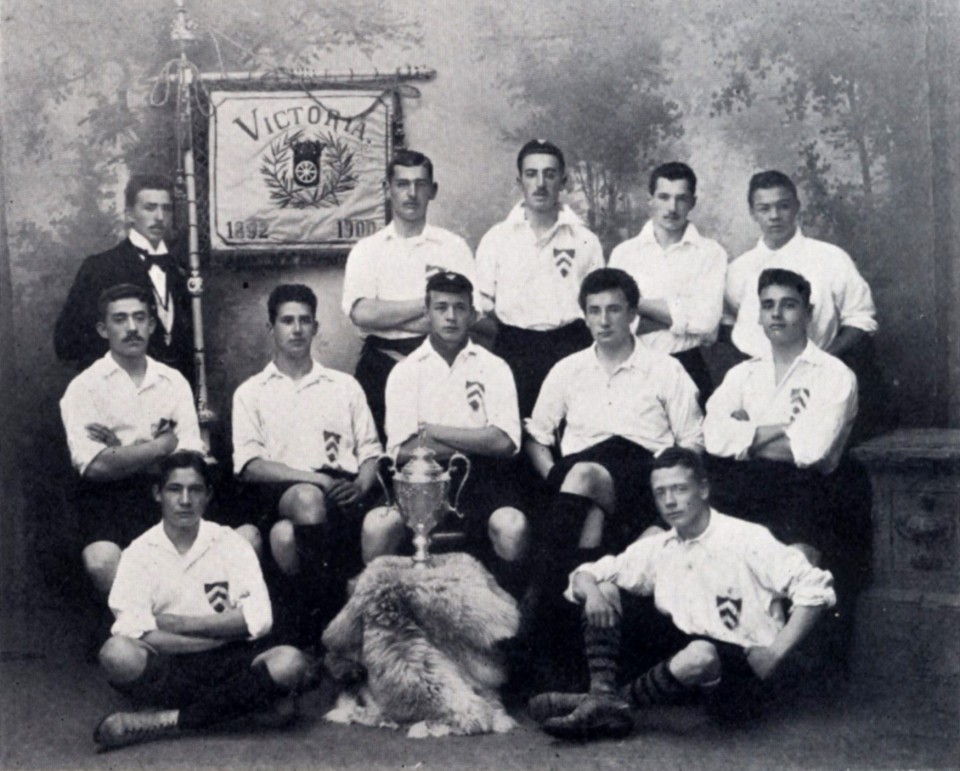
The players of Victoria in 1900, after becoming champion of the highest eastern division of the Dutch football league. They would continue to be the best team for two more years, which gave Victoria permanent possession of the cup shown in the front of the players. This cup has survived the passage of time and is believed to be the oldest football cup in The Netherlands. From February 2015 onwards it has been exhibited in Sports Centre de Bongerd.
Wageningen, although a relatively small city, has a rich football history. Out of the five football clubs which exist today within the city boundaries, two once performed at the highest level in the Netherlands. One did so up to quite recently. FC Wageningen, nowadays known as WVV Wageningen, used to be a professional football club until its unfortunate bankruptcy in 1992. The abandoned stadium, on top of the Wageningen Mountain, still brings back the memory of those treasured years of glory. While you bring a visit, imagine the stadium being packed with more than ten thousand supporters.
GVC is the other Wageningen soccer club which once belonged to the top of the Netherlands. Just over one century ago, Wageningen was known as ‘soccer bastion of the Dutch east’. The players of Victoria, one of GVC’s two predecessors, were solely responsible. From 1900 to 1902, Victoria competed with HVV Den Haag for the Dutch championship. Although all three seasons HVV came out victorious, Victoria was not left empty-handed. Having become champion of the eastern district three seasons in a row, Victoria earned permanent possession of the floating trophy. Even now, more than hundred years later, the trophy is still in possession of GVC and believed to be the oldest Dutch football cup around. From February 2015 onwards, the cup can be admired at the entrance of Sports Centre de Bongerd, the current home ground of GVC.
In 1903 Victoria (founded in 1892) merged with Go Ahead (founded in 1886) to become Go Ahead Victoria Combination, or, in short: GVC. History would repeat itself when in the seasons 1910-1911 and 1911-1912 GVC became champion of the eastern district, but in both years failed to win the two legged-tie for the overall Dutch championship against Sparta Rotterdam.
Those years, at the beginning of the 20th century, were the golden years of GVC. Victories over Ajax and Antwerp FC, during a 1912 Easter tournament which eventually was won by GVC, would prove to be the last achievement of national concern. In subsequent years GVC gradually sloped down into lower levels. Key players moved to other clubs, both within and outside the Netherlands. Some players pursued their happiness on the other side of the Atlantic, and contributed to the spread of football in the USA. Another one joined the ranks of AC Milan, only to be treated as an outsider. When he and other players started their own soccer club, Internationale Milan, they opened a new chapter of football history.
Whereas former opponents as Ajax, Antwerp, Sparta and Vitesse Arnhem still participate in national or even international competitions, GVC nowadays performs in regional competitions. Nevertheless, it is an achievement in and of itself that today the club still exists at all. GVC is one of the oldest Dutch soccer clubs still active. Its earliest predecessor, Go Ahead, was founded no later than 1886 – just seven years after the famous sport pioneer Pim Mulier grounded the first Dutch football club.
In 1932, GVC officially became a student club. As such, up till today GVC has harboured players from all over the world, who nonetheless all speak the same language: the language of football. Read more about GVC anno today.
For those readers who would like to know more about our history, a detailed description of our history can be found here (in Dutch).

